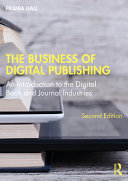The Business of Digital Publishing An Introduction to the Digital Book and Journal Industries 2nd Edition by Frania Hall ISBN 9780429751622 0429751621
$50.00 Original price was: $50.00.$25.00Current price is: $25.00.
The Business of Digital Publishing An Introduction to the Digital Book and Journal Industries 2nd Edition by Frania Hall – Ebook PDF Instant Download/Delivery: 9780429751622 ,0429751621
Full download The Business of Digital Publishing An Introduction to the Digital Book and Journal Industries 2nd Edition after payment

Product details:
ISBN 10: 0429751621
ISBN 13: 9780429751622
Author: Frania Hall
The Business of Digital Publishing An Introduction to the Digital Book and Journal Industries 2nd Edition Table of contents:
Part I Technology context for digital publishing
Introduction to Part I
1 Developments towards digital production
Introduction
Developments towards digital publishing
Typesetting
Word processing
Desktop publishing systems
Database
Technological developments towards digital printing
Changing business models due to print on demand
Changing production processes and workflow
One input many outputs
Savings in cost and time
The warehouse and digital printing
Data warehouses and data asset management systems
Conclusion: changing publishing structures
2 Structure for data
Introduction
Tagging, mark-up and the growth of XML
Imposing a format
XML-first workflow
Accessible formats
Metadata: data about data
Document object identifiers
Metadata for searching
Metadata and marketing
Metadata and consumer insight
Case study: The importance of metadata for discoverability
Taxonomies and schemas: organising metadata
RDF: dealing with different types of data
Topic maps
Other key developments and frameworks for structured data
Managing rights and digital rights management
Conclusion: continuing advances
3 Working with the web and other technology developments
Introduction
The web and HTML
HTML5
Web 2.0 and social networking
Web developments, artificial intelligence (AI) and blockchain
Conclusion: the more flexible web
4 Organising content and the digital development process
Introduction
Information architecture
The development process
User experience design (UX design)
Content management
Some considerations for CMS
Enterprise content management or intelligent information management
Knowledge management and storage issues
Storage and software as a service
Conclusion: CMS development driving opportunities
5 The context for ebook formats, e-readers and digital products
Introduction
The development of ebook formats
The development of e-readers
Initial ebook pricing dilemmas – wholesale vs. agency
Smartphones, tablets and new readerships
Tablets
Mobile-first – the content ecosystem
Digital formats and digital tools for publishing
Apps
Reflowable and fixed layout EPUB
iBooks
Open-source approaches to e-reading as alternatives for publishers – Readium
App and web project development
Audio
Digital rights management technologies
Conclusion: the changing view of the book
Conclusion to Part I
Further reading and resources
Part II Publishing sectors
6 Developments in digital professional reference publishing
Introduction
A look at consumer reference
Transforming to digital – Encyclopaedia Britannica
Specialist markets
The benefits of digital publishing for reference
Early developments in specialist reference
Continuous integration and organisation of updates
Search
Automatic compilation of updates
Timeliness
Usage
The early electronic products: CD-ROMs
Problems with CD-ROMs – the challenges of changing formats
Database products
Infrastructure requirements and organisational change
The data asset
Migration issues as digital products are developed
The drive for migration from print to digital
Early sales activity
Price and migration – accommodating the print legacy
Encouraging migration
Changing relationships with customers in the specialist sector
Key customers
Medium-sized customers
Other customer groups
Ongoing product development
Market research for product development
Approaches to product development
Rise of tablets
Pricing and sales models for legal reference
Early pricing problems
Pricing the bundle
Subscriptions, licences and pay per view
Customised pricing
New product development
Building on existing products
Tailored products for market segments
Flexibility of use
Content dilemmas
Case study: Offering information solutions – the BMJ
Providing information services
Conclusion
Further reading and resources
7 Developments in digital publishing for the academic market
Introduction
Context: the research environment
What is research publishing?
Drivers of the market
Journals and monographs
The publisher/academic circle
STM and HSS
Scholarly research customers
Peer review and the role of publishers
Who owns the research?
The development of digital products
The benefits of digital over print
The value of content to the library
The early development of new digital products
Digital repositories: the researcher’s ecosystem
University and other free repositories
Competing with free repositories – why go with a publisher?
Digital journal services
Benefits for users
Citation and reference tools
Benefits for libraries
The importance of usage
Permissions for research
Product sales and ‘big deals’
Aggregators
The challenges for digital journals
The open access challenge
Open access models
Pay to publish
The question of speed
Decline of the big deal and evolving token systems
Transformative journals and transformative agreements
The monograph: the scholarly publisher’s next challenge
Print on demand
Increased access for monographs
Demand-drive acquisition (patron-driven acquisition)
Open access and books
Books as a research resource and aggregation
Creating the archive
New flexible formats
Future directions: problems and opportunities
Declining budgets
Are publishers necessary?
Philanthropy
Future research models with public peer review
Solutions development
Research publishing in China
Where next for academic publishing?
Conclusion
Further reading and resources
8 Developments in digital publishing in the education market
Introduction
Context: introduction to the textbook market
Textbooks in the US and UK markets
Schools and HE textbooks: the US market
The effect of adoptions for schools and HE
Schools and HE texts: the UK market
Schools
HE sector
Characteristics of the schools market for publishing
The curriculum drive for publishers
Technology in UK schools
EdTech
Digital products for schools
Features and benefits
What do the digital products look like?
Issues for publishers
Cost
Technology
Flexibility and user-friendliness
The changing business model and school budget limitations
Sales strategies for these products
Opportunities for more cost-effective publishing: textbooks in Spain
New product development and the future of digital schools publishing
Licensing content
Using data
Higher education, e-learning and blended learning
The early development of digital resources for lecturers and students
Developments in e-learning
Technology infrastructure for e-learning
The new e-textbooks
Resources for lecturers
Ebook readers and the future of the print text
Blended learning – creating flexible resources
Other content-based approaches – integrating at institutional level
Ebook providers, aggregators and other EdTech solutions for higher education
Case study: An experiment in textbook creation – Apple’s iBook textbook
Future directions for the education sector
New ventures
Solutions
Government funding and other initiatives
The role of the author and the standardised text
Learning communities
Conclusion
Further reading and resources
9 Developments in digital publishing for consumer markets
Introduction
1. Exploring the ebook
A brief history of ebook publishing
Drivers of the growth of ebook market e-readers
Case study: Early initiatives
Early ebook challenges and the evolving ebook model
Digitisation by publishers
Digital rights
Types of books to digitise
Early issues around prices
The evolving ebook business model
The growing market
Print supports digital
The evolving pricing model
Impact of agency pricing dilemma
Phasing
New models
Genre publishing
Digital-only and digital first imprints
Case study: Providing customer choice – early experiments in format
Digital-led businesses
Subscription packages
Innovations in book selling
Distributing ebooks
Libraries
Issues for the print product
Problems with ebooks
The effects for authors
Case study: E-reading in Europe – Tolino
2. Other digital products
Enhanced ebooks
Definitions
Early ebooks
Problems for enhanced ebooks?
Some advantages
Book apps
The challenges of producing apps
Question of scale
Development strategies
Business models
App pricing: the challenge of low prices
Further challenges: apps vs. books
Is an app worth it?
Audio
Growth
Some definitions
Subscriptions
Future developments
Futurizing the book
Conclusion
Further reading and resources
Part III Digital publishing issues
Introduction to Part III
10 Copyright, piracy and selling rights
Introduction
Copyright
Some key tenets of copyright
Problems with the basis of copyright in the digital environment
Does copyright need fixing?
Copyleft
Open content and Creative Commons copyright licences
Copyright infringement and DRM
Piracy
Who is involved?
How to combat piracy
Complexities of managing rights
Planning the deal: what do rights people have to bear in mind?
Content and value
Technical details
Bundles
Option clauses and other contract arrangements
Conclusion
Further reading and resources
11 Digital marketing, social media and discoverability
Introduction
Introducing issues for digital marketing
Print vs. digital marketing
Recommendations, algorithms and SEO
Reader recommendation and booklovers sites
Social reading platforms
Consumer insight
Paid – earned – owned
Marketing analytics
Book candy for book data – Jelly Books
Data in other areas of publishing and big data
Discoverability
Browsing
Authors’ social capital
Book candy for book data – Jelly Books
Digital marketing activities
Web marketing, microsites and audience development
Social media and word-of-mouth marketing
User-generated content on blogs and social media
New audiences and content development
Case study: Nosy Crow’s free book
Continuing change
Conclusion
Further reading and resources
12 New working practices and creative entrepreneurship
Introduction
Professional services
Project set-up
Ongoing
Consumer services
Offshoring or in-house?
New publishing businesses and creative entrepreneurship
Creative incubators
Crowdfunding model – with publishing nous
Digital innovation for print products
Developing media brands
Hybrid publishing approaches created by writers
Digital personalisation to encourage reading
Conclusion
Further reading and resources
13 Self-publishing and other digital reader/writer economies
Introduction
Self-publishing
Kindle Direct Publishing
Alternative spaces for content – defining a reader–writer economy
Fanfiction
Social writing platforms
Bookouture – another hybrid approach
Publishers and self-publishing
Writers programmes and author support – overcoming barriers
Publishers identifying markets
Conclusion
Further reading and resources
14 Futurizing publishing structures
Introduction
The changing value chain
Challenging and reorienting the traditional value chain
Legacy structures
Reorganising publishing structures in the specialist sectors
Predicting change in trade publishing
Conclusion
Further reading and resources
Final word
Index
People also search for The Business of Digital Publishing An Introduction to the Digital Book and Journal Industries 2nd Edition:
the business of media
the business of media distribution
the business of media distribution pdf
the business of books
digital publishing business
Tags: Frania Hall, Business, Digital Publishing, Digital Book, Journal Industries
You may also like…
Business & Economics - Management & Leadership
Building the Agile Business through Digital Transformation 2nd Edition Perkin
Uncategorized
Reference - Writing
The Language of Publishing An A to Z Glassry by Independent Book Publishers 1938646029 9781938646027
Reference - Writing
Book Wars The Digital Revolution in Publishing 1st Edition John B. Thompson
Uncategorized
Business & Economics - Economics
Business & Economics
Uncategorized
Beginner’s Guide to Digital Painting in Photoshop (2nd edition) 3Dtotal Publishing (Editor)











